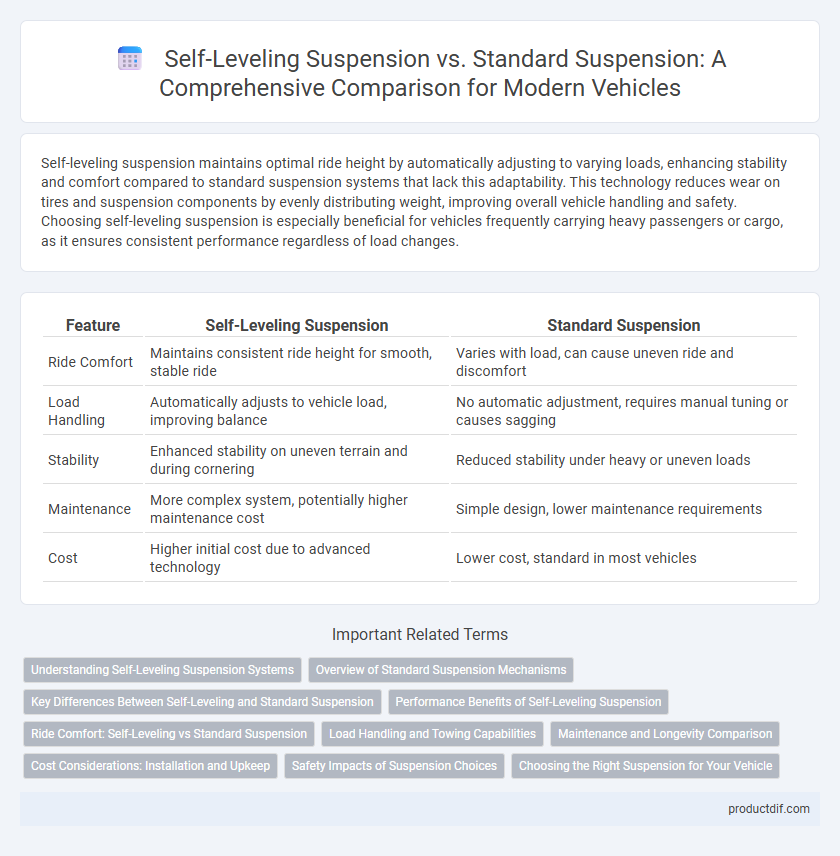Self-leveling suspension maintains optimal ride height by automatically adjusting to varying loads, enhancing stability and comfort compared to standard suspension systems that lack this adaptability. This technology reduces wear on tires and suspension components by evenly distributing weight, improving overall vehicle handling and safety. Choosing self-leveling suspension is especially beneficial for vehicles frequently carrying heavy passengers or cargo, as it ensures consistent performance regardless of load changes.
Table of Comparison
| Feature | Self-Leveling Suspension | Standard Suspension |
|---|---|---|
| Ride Comfort | Maintains consistent ride height for smooth, stable ride | Varies with load, can cause uneven ride and discomfort |
| Load Handling | Automatically adjusts to vehicle load, improving balance | No automatic adjustment, requires manual tuning or causes sagging |
| Stability | Enhanced stability on uneven terrain and during cornering | Reduced stability under heavy or uneven loads |
| Maintenance | More complex system, potentially higher maintenance cost | Simple design, lower maintenance requirements |
| Cost | Higher initial cost due to advanced technology | Lower cost, standard in most vehicles |
Understanding Self-Leveling Suspension Systems
Self-leveling suspension systems automatically adjust the vehicle's ride height by using sensors and hydraulic or air pressure to maintain optimal balance regardless of load changes, ensuring consistent handling and ride comfort. Standard suspension systems rely on fixed springs and dampers that do not adapt to varying weight distributions, potentially leading to uneven tire wear and compromised stability when carrying heavy loads. By maintaining an even chassis level, self-leveling suspension enhances safety, prevents headlight misalignment, and improves overall driving dynamics compared to conventional setups.
Overview of Standard Suspension Mechanisms
Standard suspension mechanisms typically consist of components such as coil springs, leaf springs, shock absorbers, and struts designed to absorb road shocks and maintain tire contact. These systems rely on fixed mechanical parts that compress and rebound based on road conditions, providing basic ride comfort and vehicle stability. Unlike self-leveling suspensions, standard suspensions do not automatically adjust ride height in response to load changes, resulting in variable handling and comfort under different driving conditions.
Key Differences Between Self-Leveling and Standard Suspension
Self-leveling suspension automatically adjusts the vehicle's ride height to maintain a consistent level, improving handling and comfort under varying loads, whereas standard suspension relies on fixed components that do not adapt to changes in weight. Self-leveling systems use sensors and air springs or hydraulic mechanisms to compensate for cargo or passenger weight, reducing body roll and enhancing stability. Standard suspensions, typically composed of coil or leaf springs, offer simplicity and lower cost but compromise ride quality when the vehicle is heavily loaded or unevenly weighted.
Performance Benefits of Self-Leveling Suspension
Self-leveling suspension enhances vehicle stability and handling by automatically adjusting to changes in load, maintaining a consistent ride height and optimal suspension geometry. This system improves ride comfort and reduces body roll during cornering, which contributes to safer, more precise driving performance. Compared to standard suspension, self-leveling suspension ensures better tire contact with the road, resulting in improved traction and braking efficiency.
Ride Comfort: Self-Leveling vs Standard Suspension
Self-leveling suspension systems maintain consistent vehicle height regardless of load, significantly improving ride comfort by reducing body roll and minimizing road vibrations. Standard suspension systems often experience sagging under heavy loads, leading to uneven tire wear and a harsher driving experience. Vehicles equipped with self-leveling suspension provide smoother handling and enhanced stability, especially on rough terrain or during long trips.
Load Handling and Towing Capabilities
Self-leveling suspension maintains consistent ride height by automatically adjusting to varying loads, enhancing load handling by preventing sagging and improving stability. Standard suspension lacks this adaptive feature, often resulting in uneven weight distribution and reduced control during towing. Vehicles equipped with self-leveling suspension provide safer towing capabilities by minimizing trailer sway and maintaining optimal suspension geometry.
Maintenance and Longevity Comparison
Self-leveling suspension systems require more complex maintenance due to additional components like compressors and sensors, increasing the likelihood of repair needs compared to standard suspension. Standard suspension systems have simpler designs, resulting in generally lower maintenance costs and easier servicing over time. Longevity for self-leveling suspensions can be shorter if components fail, while standard suspensions tend to have longer service lives with routine maintenance.
Cost Considerations: Installation and Upkeep
Self-leveling suspension systems generally incur higher installation costs due to complex components like sensors, compressors, and hydraulic or air systems, whereas standard suspension involves simpler, more affordable setups. Maintenance expenses for self-leveling suspension are typically greater over time because of specialized parts and the need for periodic system checks, compared to the lower upkeep costs associated with standard suspension systems. Budget-conscious vehicle owners weighing cost considerations often prefer standard suspension for initial affordability and reduced long-term maintenance.
Safety Impacts of Suspension Choices
Self-leveling suspension enhances vehicle stability by automatically adjusting ride height to maintain optimal tire contact, reducing body roll and improving braking performance in varying load conditions. Standard suspension lacks this adaptability, increasing the risk of uneven tire wear and compromised handling, especially under heavy loads or uneven terrain. Choosing self-leveling suspension directly contributes to safer driving dynamics by ensuring consistent traction and better control during emergency maneuvers.
Choosing the Right Suspension for Your Vehicle
Self-leveling suspension maintains a consistent ride height regardless of load, enhancing stability and comfort, which is ideal for vehicles frequently carrying heavy cargo or passengers. Standard suspension offers a simpler, cost-effective solution but may result in uneven handling and reduced ride quality under varying loads. Selecting between self-leveling and standard suspension depends on your vehicle's typical usage, load requirements, and budget considerations.
Self-Leveling Suspension vs Standard Suspension Infographic

 productdif.com
productdif.com